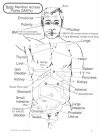A randomised controlled trial of the Neuro Emotional Technique (NET) for childhood Attention Deficit Hyperactivity Disorder (ADHD): a protocol
- PMID: 19173743
- PMCID: PMC2646715
- DOI: 10.1186/1745-6215-10-6
A randomised controlled trial of the Neuro Emotional Technique (NET) for childhood Attention Deficit Hyperactivity Disorder (ADHD): a protocol
Abstract
Background: An abundance of literature is dedicated to research for the treatment of Attention Deficit Hyperactivity Disorder (ADHD). Most, is in the area of pharmacological therapies with less emphasis in psychotherapy and psychosocial interventions and even less in the area of complementary and alternative medicine (CAM).The use of CAM has increased over the years, especially for developmental and behavioral disorders, such as ADHD. 60-65% of parents with children with ADHD have used CAM. Medical evidence supports a multidisciplinary approach (i.e. pharmacological and psychosocial) for the best clinical outcomes. The Neuro Emotional Technique (NET), a branch of Chiropractic, was designed to address the biopsychosocial aspects of acute and chronic conditions including non-musculoskeletal conditions. Anecdotally, it has been suggested that ADHD may be managed effectively by NET.
Design/methods: A placebo controlled, double blind randomised clinical trial was designed to assess the effectiveness of NET on a cohort of children with medically diagnosed ADHD. Children aged 5-12 years who met the inclusion criteria were randomised to one of three groups. The control group continued on their existing medical regimen and the intervention and placebo groups had the addition of the NET and sham NET protocols added to their regimen respectively. These two groups attended a clinical facility twice a week for the first month and then once a month for six months. The Conners' Parent and Teacher Rating Scales (CRS) were used at the start of the study to establish baseline data and then in one month and in seven months time, at the conclusion of the study. The primary outcome measures chosen were the Conners' ADHD Index and Conners' Global Index. The secondary outcome measures chosen were the DSM-IV: Inattentive, the DSM-IV:Hyperactive-Impulsive, and the DSM-IV:Total subscales from the Conners' Rating Scales, monitoring changes in inattention, hyperactivity and impulsivity. Calculations for the sample size were set with a significance level of 0.05 and the power of 80%, yielding a sample size of 93.
Discussion: The present study should provide information as to whether the addition of NET to an existing medical regimen can improve outcomes for children with ADHD.
Trial registration: Australian New Zealand Clinical Trial Registration Number: ANZCTRN 012606000332527.
Figures
Similar articles
-
A comparison of once-daily and divided doses of modafinil in children with attention-deficit/hyperactivity disorder: a randomized, double-blind, and placebo-controlled study.J Clin Psychiatry. 2006 May;67(5):727-35. doi: 10.4088/jcp.v67n0506. J Clin Psychiatry. 2006. PMID: 16841622 Clinical Trial.
-
A Phase III, Randomized, Double-Blind, Placebo-Controlled Trial Assessing the Efficacy and Safety of Viloxazine Extended-Release Capsules in Adults with Attention-Deficit/Hyperactivity Disorder.CNS Drugs. 2022 Aug;36(8):897-915. doi: 10.1007/s40263-022-00938-w. Epub 2022 Jul 27. CNS Drugs. 2022. PMID: 35896943 Free PMC article. Clinical Trial.
-
Central nervous system stimulants for secondary attention deficit-hyperactivity disorder after paediatric traumatic brain injury: a rationale and protocol for single patient (n-of-1) multiple cross-over trials.BMC Pediatr. 2013 May 28;13:89. doi: 10.1186/1471-2431-13-89. BMC Pediatr. 2013. PMID: 23710976 Free PMC article. Clinical Trial.
-
The efficacy and safety profile of lisdexamfetamine dimesylate, a prodrug of d-amphetamine, for the treatment of attention-deficit/hyperactivity disorder in children and adults.Clin Ther. 2009 Jan;31(1):142-76. doi: 10.1016/j.clinthera.2009.01.015. Clin Ther. 2009. PMID: 19243715 Review.
-
Immediate-release methylphenidate for attention deficit hyperactivity disorder (ADHD) in adults.Cochrane Database Syst Rev. 2021 Jan 18;1(1):CD013011. doi: 10.1002/14651858.CD013011.pub2. Cochrane Database Syst Rev. 2021. PMID: 33460048 Free PMC article.
Cited by
-
Treatment of type 2 diabetes and stress using neuro-emotional technique: case report.Front Endocrinol (Lausanne). 2024 Jul 10;15:1382757. doi: 10.3389/fendo.2024.1382757. eCollection 2024. Front Endocrinol (Lausanne). 2024. PMID: 39050563 Free PMC article.
-
Parental perspectives on use, benefits, and physician knowledge of complementary and alternative medicine in children with autistic disorder and attention-deficit/hyperactivity disorder.J Altern Complement Med. 2013 Sep;19(9):746-50. doi: 10.1089/acm.2012.0640. Epub 2013 Apr 26. J Altern Complement Med. 2013. PMID: 23621389 Free PMC article.
-
A biopsychosocial approach to primary hypothyroidism: treatment and harms data from a randomized controlled trial.Chiropr Man Therap. 2015 Aug 20;23:24. doi: 10.1186/s12998-015-0068-5. eCollection 2015. Chiropr Man Therap. 2015. PMID: 26301086 Free PMC article.
-
Chiropractic management of a patient with symptoms of attention-deficit/hyperactivity disorder.J Chiropr Med. 2012 Sep;11(3):221-4. doi: 10.1016/j.jcm.2011.10.009. J Chiropr Med. 2012. PMID: 23449647 Free PMC article.
-
Neuro Emotional Technique as a Treatment for Separation Anxiety Related to Prenatal Stress: A Case Report.Cureus. 2025 May 6;17(5):e83558. doi: 10.7759/cureus.83558. eCollection 2025 May. Cureus. 2025. PMID: 40476104 Free PMC article.
References
-
- Dulcan M, Dunne J, Ayers W, Arnold V, Benson R, Bernet W, Buckstine O, Kinlan J, Leonard H, Licamele W, McClellan J. Practice parameters for the assessment and treatment of children, adolescents and adults with Attention Deficit/Hyperactivity Disorder. J Am Acad Child Adolesc Psychiatry. 1997;36:85S–121S. - PubMed
-
- Waslick B, Greenhill L. Attention-Deficit/Hyperactivity Disorder. In: Wiener J, Dulcan M, editor. Textbook of child and adolescent psychiatry. 3. American Psychiatric Publishing; 2004. pp. 485–508.
Publication types
MeSH terms
Substances
LinkOut - more resources
Full Text Sources
Medical
Miscellaneous




